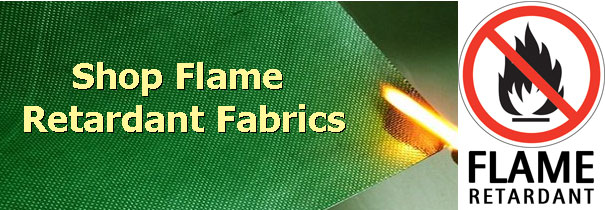Fabric Blinds Curtain Rods Window Treatments Trims & Tassels Wallpaper
Flame Resistant FAQ (Frequently Asked Questions)

- What does Fireproof Fabric mean?
-
A. Fireproof means that a fabric literally will not burn. To be labeled fireproof, the Federal Trade Commission requires that a fabric must be 100% fireproof. If the fiber or fabric has been treated to prevent flames from spreading, it must be labeled as fire resistant.
- What does Flameproof Fabric mean?
-
A. Flameproof is a synonym for fireproof.
- What is a Flame Retardant Fabric?
- A. A fabric that resists or retards the spreading of flames. A flame retardant fabric can be made by using fibers that are themselves flame retardant (inherently flame retardant) or by using special finishes on fabrics.
- What is a Fire Resistant fabric?
- A. Fire resistant refers to a fabric or fiber that has been treated to discourage the spreading of flames.
- What are the different fire ratings and codes?
-
A. NFPA 701 Test Method #1 is for lightweight, single layer draperies. In this test, a hanging fabric is exposed to a flame for a specified amount of time; whether it passes depend on how much weight the fabric loses when it burns and whether any pieces that break off continue to burn. This second criterion is sometimes called drip burn.
- What is the test method for flame spread?
-
A. The tunnel test measures how far and how fast flames spread across the surface of the test sample. In this test, a sample of the material 20 inches wide and 25 feet long, is installed as ceiling of a test chamber and exposed to a gas flame at one end. The resulting flame spread rating (FSR) is expressed as a number on a continuous scale where inorganic reinforced cement board is 0 and red oak is 100.
Although several small-scale tests have been developed to predict flame spread ratings based on the tunnel test, these are primarily bench tests for product development. The National Fire Protection Association (NFPA) has not accepted any alternate methods for determining the flame spread characteristics of materials to be used in buildings; for this purpose, NFPA recommends only the Tunnel Test. - What is ASTM E-119?
-
ASTM E-119 is an assembly test, not a product test. This is the test method (UL) used for fire resistance rated assemblies.
- Q. What is the difference between fire retardant and fire resistance?
-
A fire retardant material slows burning across the surface of a combustible substrate.
A fire resistive material delays heat penetration through a substrate. - Fire resistance - what is an "hourly rating" and does it compare to flame spread?
- A fire-resistive rating is the time that exterior wall construction can withstand fire exposure as determined by a standard fire test. Wall construction can be classified as 4-hour, 3-hour, 2-hour, 1-hour and non-rated construction. This rating is determined by a different test, known as "Standard Methods of Fire Tests of Building Construction and Materials" NFPA No. 251, ASTM E 119, UL No. 263).
The test exposes an assembly to heat and flame on one side and tests for heat transmission, burn-through, structural integrity and ability to withstand a hose stream from a fire hose.
Hourly Ratings are assigned only to complete assemblies, of structural materials for buildings, (wall, floor, door, ceiling, roof, etc.) and generally require use of a noncombustible membrane (e.g. gypsum, masonry). Hourly ratings have are NOT assigned to any one single component of a complete assembly such as a paint coating, wall covering or other single building material. There is no such thing as a paint coating, additive or treatment that can be applied to any and all wall or ceiling configurations which will give a 1, 2 or 3 hour rating. - What is ASTM?
-
Formerly known as the American Society for Testing and Materials, ASTM International provides standards that are accepted and used in research and development, product testing, quality systems and commercial transactions around the globe.
- What is the purpose of the flame spread test?
-
The purpose of this test method is to determine the relative burning behavior of the material by observing the flame spread along the specimen. Flame spread and smoke developed index are reported.